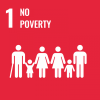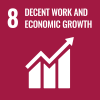Costa Rica, 14 Feb 2022 – “Migration for the benefit of all” has become a popular catchphrase for migration managers across the world. As human mobility mounts, stakeholders in governments and civil society organizations team up to refine how that movement can benefit migrants and host communities alike.
Yet "Migration for the benefit of all” is much more than a slogan to someone like Daysi Jimenez living on Costa Rica’s border with Panama.
She is one of four indigenous “cultural advisers” collaborating with the International Organization for Migration (IOM) in Costa Rica.
Anyone visiting this tiny village would know instantly that Daysi, in her bright blue, embroidered ankle-length gown, is part of a traditional community, the Ngäbe-Buglé, who have lived in these rugged hills for centuries.
Yet, unless those visitors are somehow connected with the annual coffee harvest, very few will see what she actually does. The child of migrants who crossed into Costa Rica from Panama, Daysi Jimenez helps ensure migration today really does benefit all, starting with the migrants themselves.
Daysi helps migrants engage with their employers as well as with local officials as they manage the rigours of travel and arduous work. Many Ngäbe-Buglé come from deep inside Panama, often travelling up to five hours by bus to the border and then another day reaching coffee farms. Their journeys can last months during the harvest, which usually begins in mid-July.

Daysi Jimenez is cultural adviser working among migrant workers harvesting coffee beans on Costa Rica’s border with Panama. Photo: IOM/Allen Ulloa
As a cultural adviser working with IOM, Daysi plays a key role, serving as a translator for the thousands of Ngäbe-Buglé coffee pickers gathering at two border crossings near her home on a large coffee plantation she helps manage for absentee owners in the United States.
The 36-year-old mother of six (and, recently, a grandmother) speaks fluent Ngöbere, the principal language used within the indigenous Ngäbe-Buglé zone that straddles Costa Rica and Panama along their common frontier. Daysi’s father and mother both were born in Panama, but chose to live in Costa Rica, where Daysi was born and attended local schools, becoming fluent in Spanish.
Besides raising a family, she’s a coffee picker as well as a cultural adviser, for which IOM pays her and three other Ngäbe-Buglé advisers monthly through a local NGO called Hands For Health (H4H) that works with indigenous communities.
Daysi and her family live simply in a single-room house. They have access to electricity, and fresh water comes from a gushing mountain stream. Divided into cubicles by cloth curtains, the house is raised on stilts to save it from flooding when hurricanes strike.
During the harvest, she spends long days travelling to the border crossing to help arriving Ngäbe-Buglé complete their migration and work documents. She also offers COVID-19 advice, warning families of pickers to keep masks on at all times, and to wash hands frequently.
As a cultural adviser, Daysi serves as a bridge between the indigenous Ngäbe-Buglé coming as migrants and the host community that relies on the Ngäbe-Buglé each year to bring in coffee beans for processing.

A migratory labour traceability system incorporates a migrant worker's health data, as well as a record of where they have worked in Costa Rica. Photo: IOM/Allen Ulloa
It’s a symbiotic relationship, bringing the original “host community” of native North Americans together with the descendants of Spanish, Italian and German growers who planted the first coffee plantations here.
“They seem almost to have a spiritual relationship with the coffee plants,” says Steven Barrantes Nunez, the mayor of Coto Brus, the canton where the year’s coffee harvest begins.
Growers, he says, prize the skill of the Ngäbe-Buglé and the Ngäbe-Buglé rely on the harvest to preserve their wilderness traditions.
Daysi calculates that a single family working about three months in Costa Rica can save enough money to pay for all their needs once they return to their villages in Panama.
“Salt, sugar, rice, coffee. These are things they need to buy,” she says. Having cash from the harvest makes it possible to live by traditional means – harvesting their own food, relying on fish and game.
During this year’s coffee harvest, as many as 15,000 Ngäbe-Buglé may cross into Costa Rica, spending up to six months away from their homes but earning enough to sustain a traditional village life in an era fraught with pressures that threaten ancient cultures.

Cultural adviser Daysi Jimenez offers migrant workers key advice before they begin working in Costa Rica. Photo: IOM/Allen Ulloa
One threat, from COVID-19, remains on-going. Tight border controls had reduced the annual migrant flow by half in 2020, to about 6,500 Ngäbe-Buglé from Panama, and about 6,000 more entering Costa Rica at its northern border with Nicaragua but over the past 12 months, IOM has worked with Costa Rican health and border officials and coffee organizations to make labour migration easier.
One measure is a digitalized worker permit that was pioneered in 2020. The Carné SITLAM (Sistema de Trazabilidad Laboral Migratoria) incorporates health data, as well as a record of where a migrant picker has worked during the months-long harvest.
Dr. Pablo Ortiz, who runs the H4H foundation that Daysi Jimenez works for, says the new card will allow health officials to track who has been vaccinated and who worked together. If a COVID cluster emerges, Costa Ricans can alert pickers and growers quickly to avoid further contagion.
Daysi Jimenez keeps her focus on the migrants, and what coffee means to their survival as a community. If not for the coffee harvest, she explains, the culture of the Ngäbe-Buglé peoples itself might disappear.
“Without the harvest, families would suffer,” she says. “There would be no way to get money, except traveling to the capital (of Panama) to seek work,” Daysi says. The only other option for many would be cleaning houses for wealthier Panamanians and seldom returning to their families.
Migrating temporarily to Costa Rica to harvest coffee not only provides enough money for the rest of the year but also keeps households together – most pickers arrive in a family unit, with up to seven adult workers, usually, with several children in tow.
This report was written by former IOM Senior Communications Officer Joel Millman, with reporting assistance by IOM Costa Rica media officer Allen Ulloa.
For further information please contact Allen Ulloa, Tel: 506 8318 4442, Email: aulloa@iom.int



